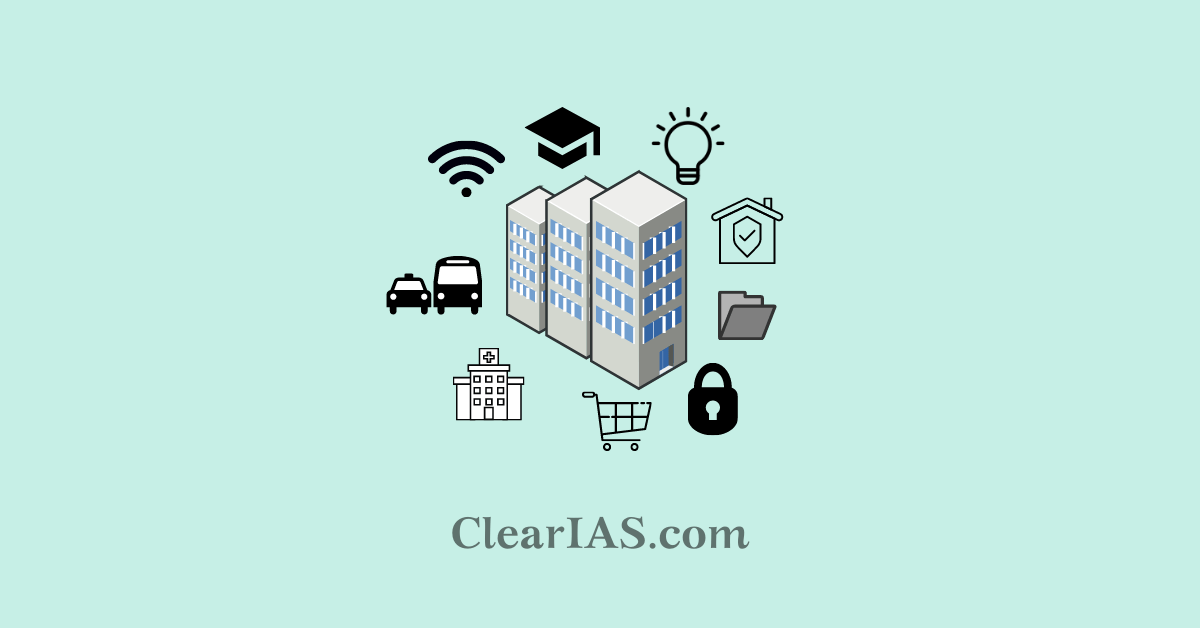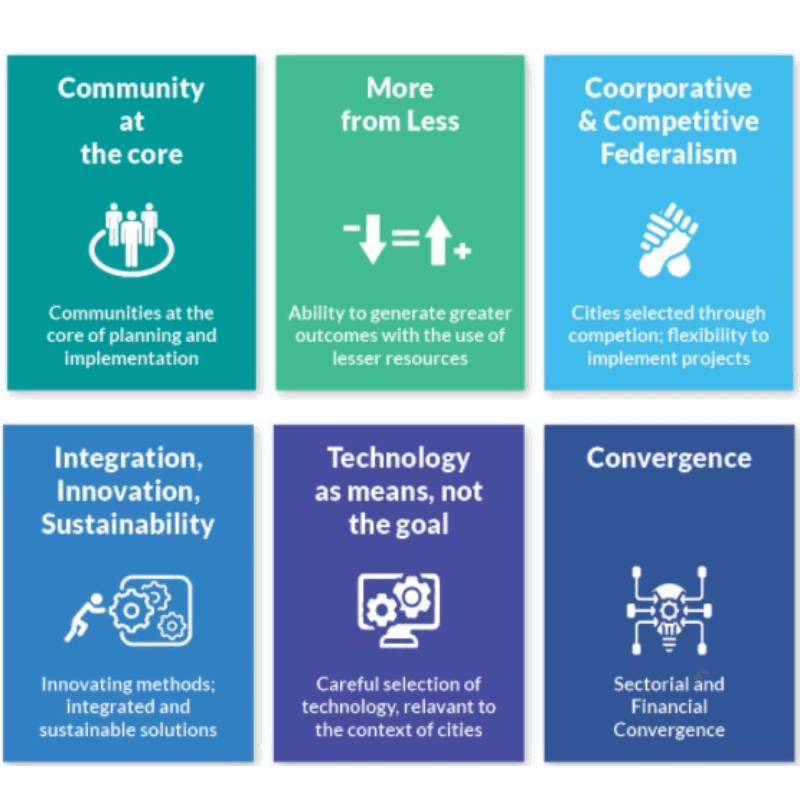 Smart Cities Mission is an innovative and new initiative by the Government of India. Read here to know all about its objectives and features.
Smart Cities Mission is an innovative and new initiative by the Government of India. Read here to know all about its objectives and features.
What is the Smart Cities Mission?
The National Smart Cities Mission is an urban renewal mission launched on June 25, 2015, to promote cities to provide core infrastructure, a clean and sustainable environment, and a decent quality of life to their citizens through the application of ‘smart solutions’.
The purpose of the Smart Cities Mission is to drive economic growth and improve the quality of life of people by enabling local area development and harnessing technology, especially technology that leads to Smart outcomes.
The Ministry of Housing and Urban Affairs (MoHUA) is the implementing ministry in collaboration with the respective state governments. It is a centrally sponsored scheme that initially included 100 cities to be covered between 2019 and 2023.
Features of the Smart Cities Mission:
The use of Information and Communications Technology (ICT) is the major aspect of the mission.
- For this Integrated Command and Control Centres(ICCCs) were set up by the municipalities.
- The ICCCs are set up to coordinate traffic management, surveillance, utilities, and grievance redressal.
- Out of the 100 municipalities in the Smart Cities Mission, the ICCCs of 70 cities are online or operational.
- These ICCCs were converted into CoVID-19 war rooms during the peak of coronavirus pandemic for public areas surveillance, tracking positive cases and health workers, heat mapping, virtual training, etc.
The Ministry of Urban Development has identified 24 key areas that cities must address in their ‘smart cities’ plan.
- Out of these 24 key areas, three are directly related and seven are indirectly related to water such as Smart-metre management, leakage identification, preventive maintenance, and water quality modeling.
Smart Cities Mission is one of the mechanisms that will help functionalize the nationwide implementation of the Sustainable Development Goals (SDG) with priorities like poverty alleviation, employment, and other basic services.
In the context of our country, the six fundamental principles on which the concept of Smart Cities is based are:

Funding and implementation of the mission:
- Central Government will give financial support to the extent of Rs. 48,000 crores over 5 years i.e. on an average Rs.100 crore per city per year. An equal amount on a matching basis is to be provided by the State/Urban Local Bodies (ULB).
- Additional resources are to be raised through convergence, from ULBs’ funds, grants under Finance Commission, innovative finance mechanisms such as Municipal Bonds, other government programs, and borrowings.
- Emphasis has been given to the participation of the private sector through Public-Private Partnerships (PPP).
- Citizens’ aspirations were captured in the Smart City Proposals (SCPs) prepared by the selected cities.
The implementation of the Mission at the City level will be done by a Special Purpose Vehicle (SPV) created for the purpose. The SPV will plan, appraise, approve, release funds, implement, manage, operate, monitor, and evaluate the Smart City development projects.
Each Smart City will have an SPV which will be headed by a full-time CEO and have nominees of Central Government, State Government, and ULB on its Board.
The States/ULBs shall ensure that:
- a dedicated and substantial revenue stream is made available to the SPV to make itself sustainable and could evolve its creditworthiness for raising additional resources from the market
- Government contribution for Smart City is used only to create an infrastructure that has public benefit outcomes.
The execution of projects may be done through joint ventures, subsidiaries, public-private partnerships (PPP), turnkey contracts, etc. suitably dovetailed with revenue streams.
The selection process of the smart cities:
The selection process of Smart Cities was based on the idea of Competitive and Co-operative Federalism. It is for the first time in the urban history of India that cities were selected based on competition.
A two-stage selection process was followed and 100 smart cities were first distributed amongst the States and UTs based on equitable criteria.
- States/UT shortlisted potential smart cities based on certain pre-conditions and scores.
- Then each of the potential 100 smart cities prepared their Smart City Proposal (SCP) which contained the model chosen (retrofitting or redevelopment or greenfield development or a mix thereof) and additionally included a Pan-city dimension with smart solutions.
All 100 smart cities have been selected through a City Challenge Process in four rounds as below:
- 20 Smart Cities selected in Round 1 in January 2016
- 13 Smart Cities were selected in the Fast Track Round in May 2016
- 27 Smart Cities selected in Round 2 in September 2016
- 30 Smart Cities selected in Round 3 in June 2017 and
- 10 Smart Cities selected in Round 4 in January/June 2018
The Smart City Proposal (SCP) includes core-infrastructure elements such as assured water supply, electricity supply, sanitation, and solid waste management, efficient mobility and public transport, affordable housing, safety and security, health, and education.
- Smart Solutions in SCP include services that ensure that service delivery levels are achieved and measured, citizen services are seamlessly delivered, grievances are timely registered and resolved and safety is increased through video surveillance and monitoring.
Each aspiring city competes for selection as a Smart City in what is called a ‘City Challenge’. There are two stages in the selection process.
Key challenges to implementation of mission:
- Infrastructure: The use of sophisticated smart technology such as sensors are a costly and high maintenance affair. Major metropolitan areas are already challenged with replacing decades-old infrastructures, such as underground wiring, steam pipes, and transportation tunnels, as well as installing high-speed internet. Broadband wireless service is increasing, but there are still areas in major cities where access is limited.
- Security and hackers: As IoT and sensor technology use expands, so does the threat level to security. These systems become more prone to hackers and cyber-attacks. Hence, more money and resources have to be invested in security
- Individual privacy: Smart cities need to balance quality of life and invasion of privacy. While citizens can enjoy a more convenient, peaceful, and healthy environment, they would not want to be constantly monitored by cameras.
- Engaging and educating citizens: For a Smart City to thrive, it needs smart citizens who are engaged and actively taking advantage of new technologies. Hence part of the implementation process must involve educating the community on its benefits.
- Social inclusion: It’s important that Smart City planning involves the consideration of all groups of people, and not just the technologically advanced. Technology should always be working to bring people together, rather than divide them further based on income or education levels. Hence the elderly and low-income groups of people should be integrated into the smart solutions.








Leave a Reply